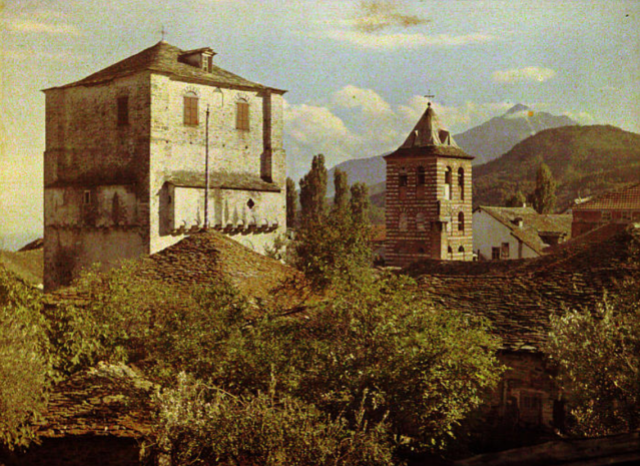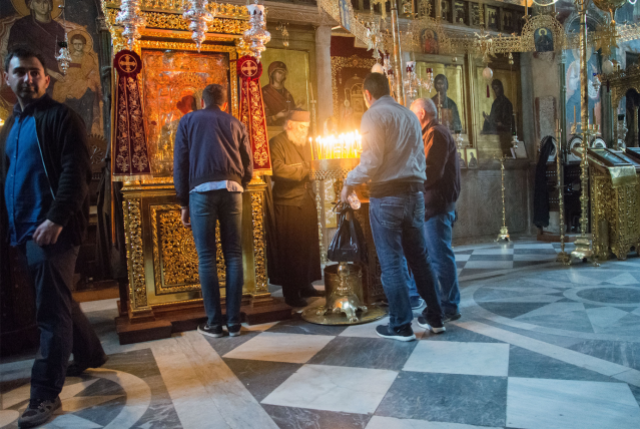 After our walk to Koutloumousiou we could finally enter the Protaton. This is the oldest church (10th century but repaired in the 13th century) and the most important church on Athos. The church is dedicated to the Dormition of the Blessed Virgin Mary. It was heavily restored during the last decade. For years and years the church wore a metal corset, both inside and outside, to keep it upright. Now the work is done.
After our walk to Koutloumousiou we could finally enter the Protaton. This is the oldest church (10th century but repaired in the 13th century) and the most important church on Athos. The church is dedicated to the Dormition of the Blessed Virgin Mary. It was heavily restored during the last decade. For years and years the church wore a metal corset, both inside and outside, to keep it upright. Now the work is done. The situation in 2009, when the whole church was covered by a enormous metal construction, and the church was hidden from the sky as a plane in a hangar.
The situation in 2009, when the whole church was covered by a enormous metal construction, and the church was hidden from the sky as a plane in a hangar. The view of the spot from the other site, made by the French photographer Fernand Cuville, around 1918, with the bell tower, the Archive tower and the Holy Mountain as a back drop.
The view of the spot from the other site, made by the French photographer Fernand Cuville, around 1918, with the bell tower, the Archive tower and the Holy Mountain as a back drop. Despite the restorations there are still impressive cracks in the frescoes. On the left we see Saint Athanasios the Athonite. He is the father of monastic life on the Holy Mountain. He went to Athos in 963 and founded Lavra. He died there due to the collapse of the apse of the church, together with six of his disciples.
Despite the restorations there are still impressive cracks in the frescoes. On the left we see Saint Athanasios the Athonite. He is the father of monastic life on the Holy Mountain. He went to Athos in 963 and founded Lavra. He died there due to the collapse of the apse of the church, together with six of his disciples.
In the middle we see the skinny Peter the Athonite. He was the very first monk entering Mount Athos. He was a hermit; lived in a cave, ate chestnuts and wore animal skins. He died before 883.
On the right is Saint Nicholas the wonderworker. The damage of this fresco is due to a pipe that was placed just in front of the painting. There have been times when the cultural and artistic value of these frescoes was not recognised.
It is probably the work of the most famous of fresco painters; Manuel Panselinos, who lived in the thirteenth century.
The frescoes are studied extensively in scientific articles. One of the questions was the technique (wet or dry) that was used and another question concerned the binding material. This is what was concluded in 2007:
“Now, however, through the application of instrumental analytical investigations, it is possible to demonstrate that a mixed technique involving both al fresco and al secco was employed. Furthermore, it was determined, on the basis of results from gas chromatography–mass spectrometry (GC/MS), that egg together with a modest amount of animal glue were the organic binding media used for the Protaton art work.”
 Venerating the most famous of icons; the Axión Estin.
Venerating the most famous of icons; the Axión Estin. The throne on which only the Byzantine emperor can sit, so the story went. But in reality it is the bishop’s stasidion (choir stall).
The throne on which only the Byzantine emperor can sit, so the story went. But in reality it is the bishop’s stasidion (choir stall).
When Vladimir Putin visited the Protaton in 2016 he stood in the throne. His expression makes me wonder. He visited Athos to celebrate the 1000 years presence of Russian monks on the Holy Mountain. Christ Anapeson at rest. A typical image of a beardless Christ reposing. A fresco from Panselinos above a wooden door.
Christ Anapeson at rest. A typical image of a beardless Christ reposing. A fresco from Panselinos above a wooden door. The same wall, with Christ and the archangels as photographed by the French photographer Roger le Baron around the First World War.
The same wall, with Christ and the archangels as photographed by the French photographer Roger le Baron around the First World War.
Bas Kamps

Very nice photo essay Bas. 😉